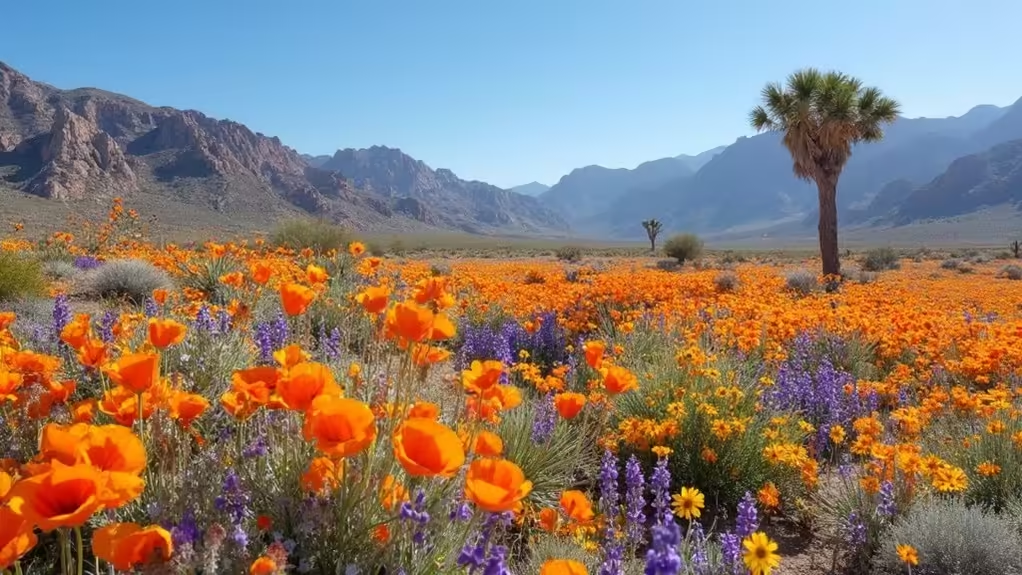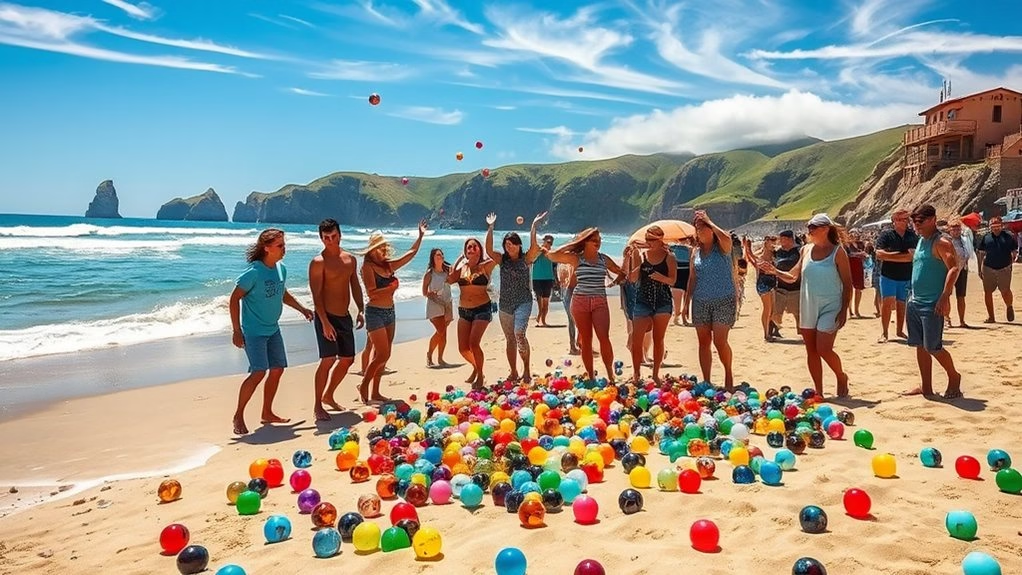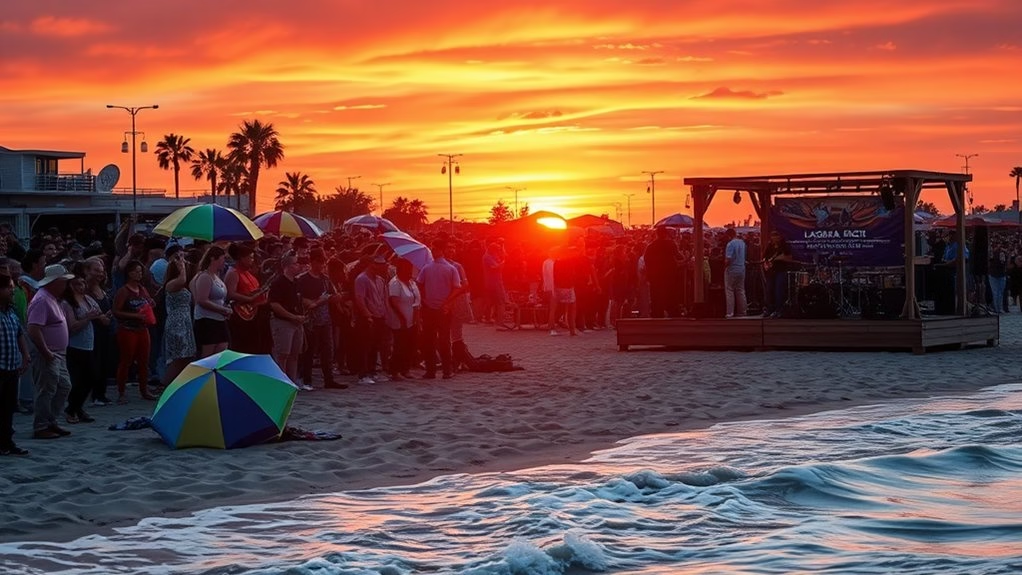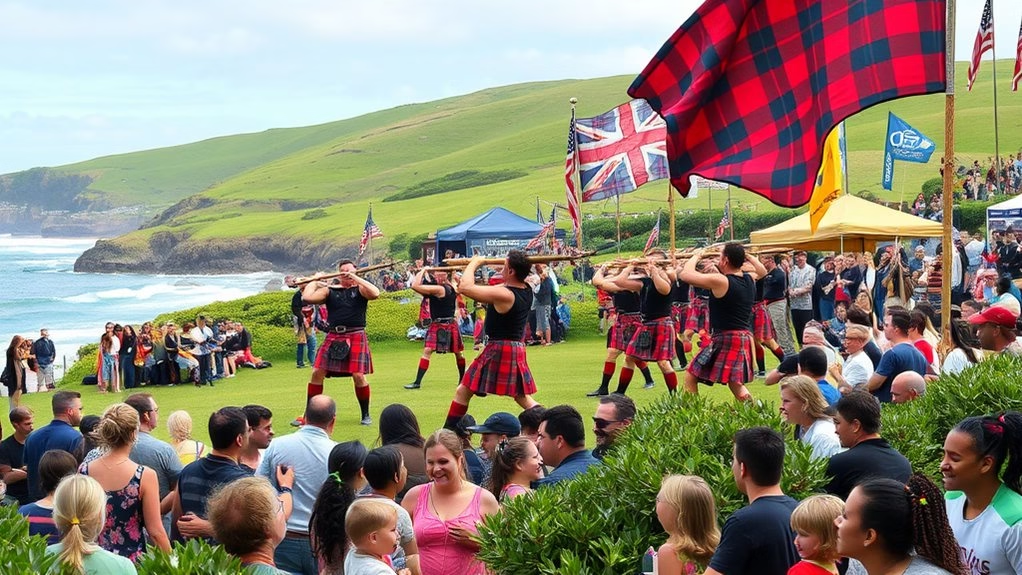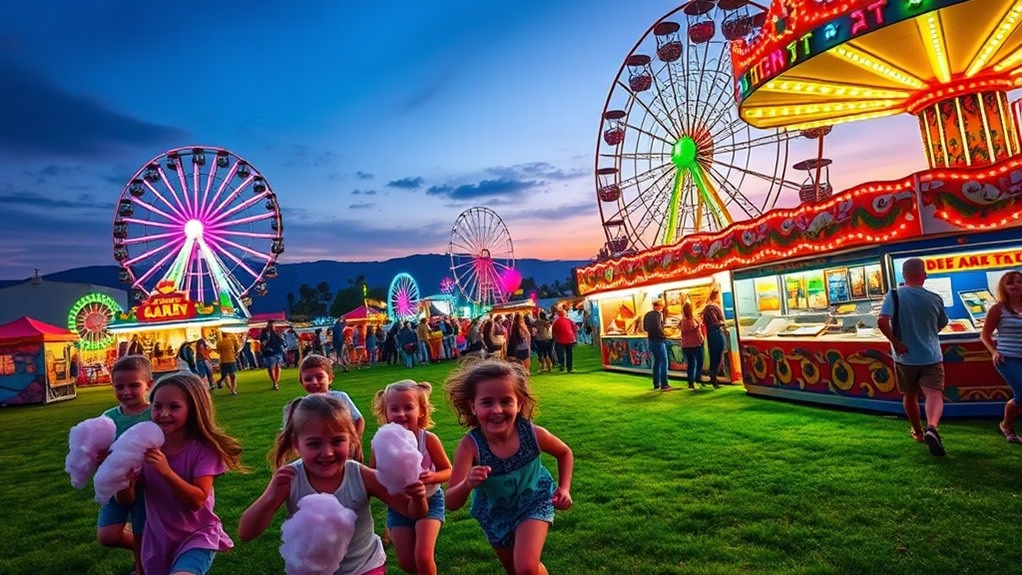California's desert wildflower blooms are a breathtaking spectacle you won't want to miss. From February to April, parks like Anza-Borrego and Death Valley change into lively carpets of color. You'll see iconic species such as bright orange California poppies and delicate desert lilies. To catch the best displays, time your visit based on rainfall and temperature patterns. Remember to stick to designated trails and practice responsible tourism to protect these fragile ecosystems. For the most stunning photos, plan your shoot during golden hour and consider using macro techniques. With the right timing and preparation, you'll experience nature's dazzling show in all its glory. Uncover more about these fleeting wonders and how to make the most of your visit.
Table of Contents
ToggleLearn More
- Anza-Borrego Desert State Park offers over 600 species of native plants blooming from mid-February to mid-April.
- Death Valley National Park transforms into a vibrant display of desert gold and purple sage from February to April.
- Joshua Tree National Park features peak blooms in March and April, with lower elevations blooming earlier.
- The optimal window for viewing California's desert wildflowers is from February to April.
- Super blooms occur approximately once a decade due to perfect environmental conditions, creating spectacular displays across desert landscapes.
Best Locations for Desert Blooms
Throughout California's desert regions, several breathtaking locations offer stunning wildflower displays during the spring months. You'll find some of the most spectacular blooms at Anza-Borrego Desert State Park, California's largest state park. Here, you can witness over 600 species of native plants bursting into color from mid-February to mid-April. It's a sight that'll make you feel truly free in nature's embrace.
For an unforgettable wildflower season experience, head to Death Valley National Park. After heavy rains, the typically barren terrain changes into a sea of desert gold and purple sage. You won't believe your eyes as you investigate this usually stark environment.
Joshua Tree National Park is another must-visit destination. As you wander through Jumbo Rocks and Hidden Valley, you'll be surrounded by lively blooms, with lower elevations flowering earlier and higher areas peaking in March and April. Don't miss the Mojave National Preserve, where you can marvel at blooming succulents and cacti against the backdrop of Kelso Dunes. For a truly awe-inspiring sight, visit Carrizo Plain National Monument, where vast fields of California poppies create a golden carpet as far as the eye can see.
Timing the Perfect Wildflower Visit
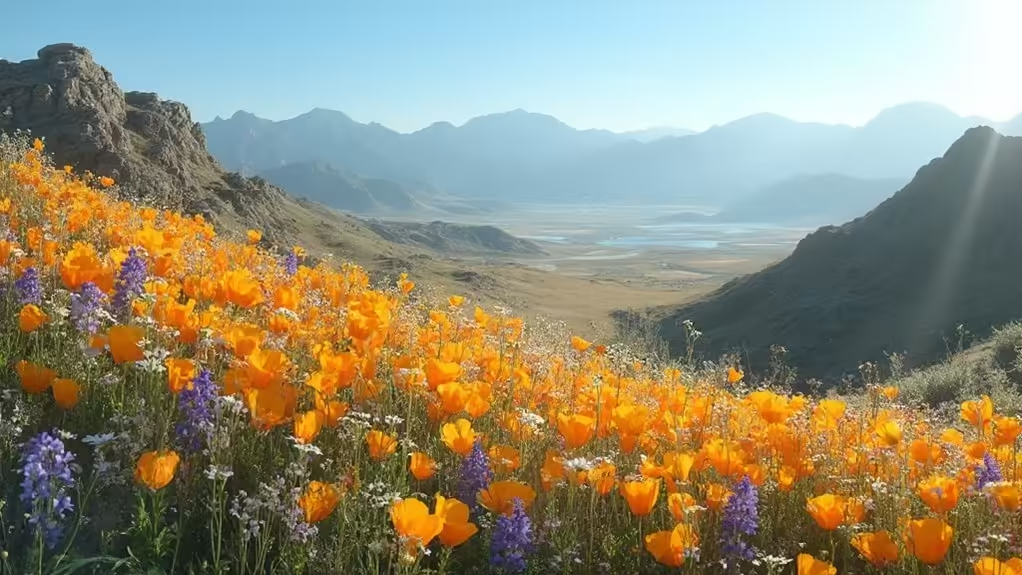
To catch California's desert wildflowers at their peak, you'll want to plan your visit between February and April. Keep a close eye on local bloom forecasts, as weather conditions play a vital role in determining when and where the best displays will occur. Remember, each desert area has its own unique timing, so you might need to adjust your plans based on the specific location you're visiting.
Peak Bloom Seasons
Timing your visit is essential for experiencing the stunning California desert wildflower blooms. You'll want to plan your excursion between mid-February and mid-April when peak blooms alter the scenery into a breathtaking canvas of colors. Each location has its own unique bloom periods, so you can chase the flowers across different parks and elevations.
In Anza-Borrego Desert State Park, you'll find the show starting in mid-February, reaching its peak in March, and lasting until April. Death Valley National Park offers a similar timeline, with the added excitement of rare super blooms every decade or so. Joshua Tree National Park gives you a longer window, from January to mid-April, with lower areas blooming first and higher elevations following suit.
For a truly spectacular sight, head to Antelope Valley California Poppy Reserve from mid-March to late April. Here, you'll witness vast fields of golden poppies stretching as far as the eye can see. By planning your visits around these peak bloom seasons, you're sure to experience the full magic of California's desert wildflowers in all their glory.
Weather's Crucial Role
While knowing the peak bloom seasons is important, understanding the weather's role in wildflower blooms can make or break your desert flower experience. Weather patterns significantly influence when and how spectacular these blooms will be. You'll want to keep an eye on late fall and early winter rainfall, as it's vital for setting the stage for a lively spring display.
To time your visit perfectly, consider these key factors:
- Substantial rainfall in the preceding months
- Cool daytime temperatures and cold nights
- Absence of excessive heat that could wither flowers prematurely
Super blooms, nature's most breathtaking displays, happen about once a decade when there's a perfect alignment of environmental factors. These rare events rely on record rainfall and ideal temperatures, creating a carpet of colors across the desert terrain.
Don't forget to monitor local weather forecasts and park updates regularly. Bloom timing can vary annually, so staying informed is your best bet for catching the flowers at their peak. With a bit of planning and a sprinkle of luck, you'll witness California's desert in its most spectacular, free-spirited form. As autumn approaches, don’t overlook the beauty found in California fall foliage destinations, where vibrant hues of red, orange, and yellow paint the landscape. These spots offer a stunning contrast to the blooming desert, proving that California’s natural wonders captivate year-round. Whether you’re chasing flowers in the spring or leaf-peeping in the fall, the state’s diversity ensures there’s always something breathtaking to experience. For those looking to immerse themselves even further in the state’s natural beauty, consider staying overnight at one of California’s scenic campgrounds. With options ranging from coastal retreats to mountain hideaways, these campgrounds provide the perfect home base for exploring the vibrant landscapes. Whether stargazing in the desert or enjoying the crisp autumn air beneath towering trees, California offers endless opportunities to connect with nature. Plus, don’t forget that the golden state isn’t just about its blooms and leaves—its rugged landscapes and unique ecosystems are year-round treasures. From stargazing under crystal-clear skies to exploring hidden oases, the california desert travel highlights offer endless opportunities for adventure and awe. No matter the season, California’s ever-changing scenery invites travelers to reconnect with nature in unforgettable ways.
Local Bloom Forecasts
Three key factors determine the ideal timing for your California desert wildflower excursion: location, seasonal patterns, and real-time updates. To catch the most lively displays, you'll want to keep an eye on local bloom forecasts. The peak bloom season typically falls between mid-February and mid-April, but this can vary depending on where you're headed.
For instance, if you're planning a trip to Anza-Borrego Desert State Park, aim for mid-March. Death Valley's colorful carpet usually unfurls from February to April, while the Antelope Valley California Poppy Reserve bursts into orange glory from mid-March to late April. Remember, rainfall plays a vital role in determining the intensity and duration of these natural spectacles.
To stay in the loop, tune into wildflower hotlines and check park websites regularly. These resources provide up-to-date information on bloom progress and can help you time your visit perfectly. By monitoring local weather forecasts and rainfall patterns, you'll increase your chances of witnessing California's desert environments change into breathtaking fields of color. Don't miss out on this fleeting display of nature's artistry!
Iconic California Desert Flower Species
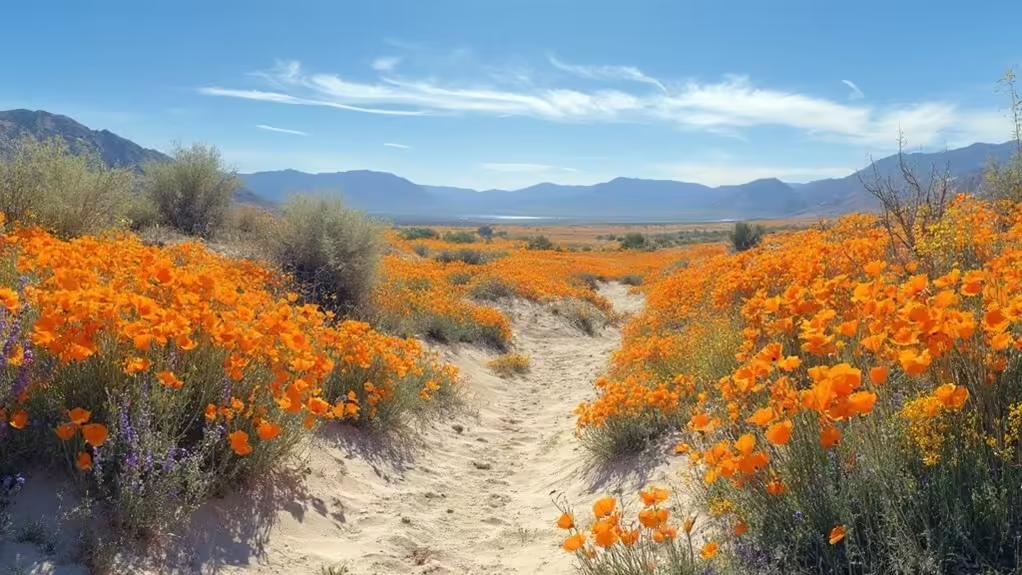
California's desert terrains burst into life with an array of iconic wildflower species during the bloom season. You'll be enchanted by the lively orange California Poppies, the state's official flower, painting entire fields from March to May. Desert Lilies stand tall with their white blossoms, thriving in sandy areas and adding a touch of elegance to the terrain. Goldfields blanket the desert floor in bright yellow, creating breathtaking vistas that'll make you feel free and alive. Among this vibrant display, Lupines contribute hues of purple, contrasting beautifully against the golden hues of the desert landscape. As you explore these natural wonders, consider unwinding at California’s top therapeutic hot springs, where the mineral-rich waters offer relaxation and rejuvenation after a long day of wildflower sightseeing. The combination of stunning natural beauty and soothing hot springs creates an unforgettable desert retreat.
As you investigate, you'll encounter:
- Blue Dicks with their purple flowers, flourishing in moist areas
- Evening Primrose, opening delicate yellow blooms at dusk
- Vast carpets of colorful blooms stretching as far as the eye can see
Don't miss the chance to witness the Evening Primrose's nocturnal display, enhancing the desert's mystique after dark. These wildflowers aren't just beautiful; they're a reflection of nature's resilience in harsh environments. Each species plays a unique role in the ecosystem, creating a diverse and stunning spectacle that'll leave you in awe of the desert's hidden wonders.
Photography Tips for Bloom Enthusiasts

Photography enthusiasts eager to capture the desert's floral splendor can enhance their shots with a few key techniques. To start, welcome the golden hour lighting, that magical time just after sunrise or before sunset. This soft, warm light will make your wildflowers glow, adding depth and richness to your images.
When you're out in the field, don't forget to focus on composition. Use the rule of thirds to create lively shots by placing your blooms off-center. This simple trick can change an ordinary photo into something extraordinary. For those who want to plunge deeper, try macro photography. Get up close and personal with the delicate petals and intricate details of each flower.
To guarantee your shots are crystal clear, especially in low light, bring along a tripod. It'll help you avoid camera shake and capture the sharpest images possible. Finally, pay attention to your background. A wide aperture can blur distractions, making your wildflowers pop against a soft, dreamy backdrop. With these photography tips in your arsenal, you'll be ready to capture California's desert blooms in all their breathtaking beauty.
Conservation Efforts and Bloom Preservation
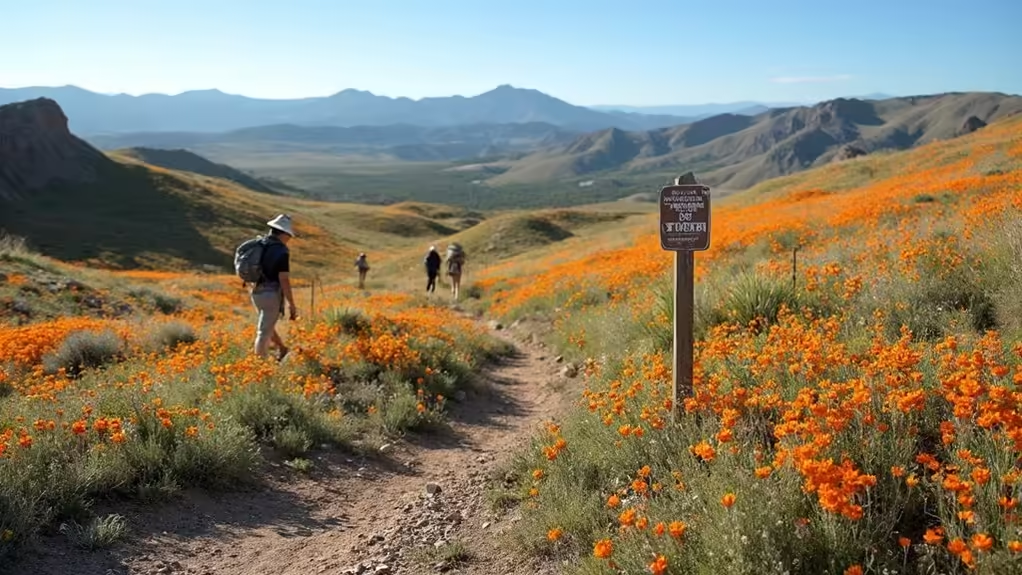
As you investigate California's desert wildflower blooms, you'll see conservation efforts in action. You can support habitat protection initiatives by staying on designated trails and refraining from picking flowers, which helps preserve these fragile ecosystems for future generations. Through visitor impact management and ongoing research, conservationists are working to guarantee that these stunning displays of nature continue to thrive, allowing you to enjoy their beauty for years to come.
Habitat Protection Initiatives
While California's desert wildflowers amaze visitors with their lively displays, conservation efforts play an essential role in protecting these delicate ecosystems. You'll find that parks and organizations are working hard to preserve these natural wonders for future generations to enjoy. They've implemented habitat protection measures that include:
- Designated trails to keep you on the right path
- Guidelines for minimizing your impact during bloom season
- Strict rules against flower picking and off-trail exploration
These initiatives aim to safeguard native plant species and their habitats. You're encouraged to participate in educational programs offered by parks, which will teach you about the importance of protecting wildflower habitats and the unique ecosystems they support.
Scientists are also studying blooming cycles and the effects of climate change on these delicate environments. Their research helps develop better conservation strategies for future blooms. You can join the effort by collaborating with local communities and organizations to promote conservation initiatives. By respecting natural habitats and following guidelines, you're helping maintain the beauty of California's iconic desert wildflower displays. Your responsible actions guarantee that these breathtaking scenes remain free for all to enjoy for years to come.
Visitor Impact Management
During peak bloom seasons, visitor impact management becomes essential for preserving California's desert wildflower displays. You'll find that responsible bloom viewing practices are vital to protect these delicate ecosystems. Stick to designated trails to minimize your impact on the environment, and remember that picking flowers is strictly prohibited. This guarantees that wildflower populations remain sustainable and future visitors can enjoy the spectacular displays.
To help you steer through your desert expedition responsibly, here's a quick guide to visitor impact management:
| Do's | Don'ts |
|---|---|
| Stay on designated trails | Pick or trample flowers |
| Observe wildlife from afar | Feed or disturb animals |
| Pack out all trash | Leave litter behind |
| Learn about local flora/fauna | Ignore educational resources |
Research and Monitoring
Conservation efforts for California's desert wildflowers extend far beyond visitor management. Research and monitoring play an essential role in preserving these natural wonders. Scientists and volunteers work together to track bloom patterns, assess habitat health, and study the impact of climate change on these delicate ecosystems.
You can become part of this important work by joining citizen science projects. Here's what you might do:
- Document wildflower sightings using smartphone apps
- Help collect soil samples for biodiversity studies
- Participate in annual bloom surveys with expert botanists
These efforts contribute to a growing database that helps researchers understand long-term trends and adapt conservation strategies. They're looking at how extreme weather events affect bloom cycles and how invasive species impact native plant communities.
State and national parks are also doing their part. They're implementing protective measures like habitat restoration and carefully managing non-native plants. Through all this work, we're learning more about the intricate relationships between wildflowers, pollinators, and the broader ecosystem.
Seasonal Weather Impacts on Blooms
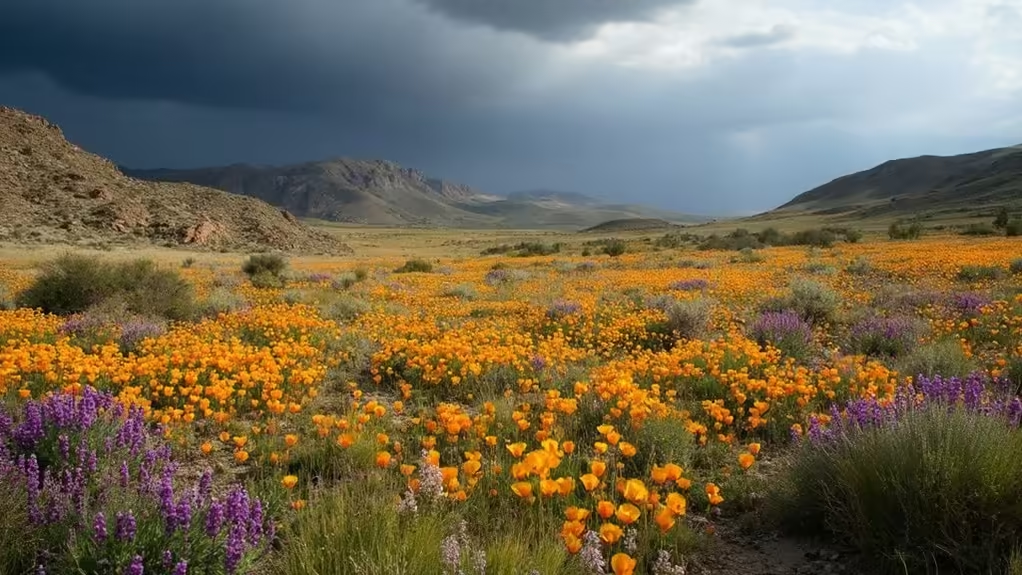
Nature's palette in California's deserts is heavily influenced by seasonal weather patterns. You'll find that late fall and early winter rains are the key to kickstarting wildflower blooms, providing the essential moisture for seeds to sprout and grow. As you examine these desert terrains, you'll notice how cool days and chilly nights during bloom season enhance the vibrancy and longevity of the flowers.
The timing of these blooms can vary widely from year to year, depending on temperature and rainfall. You're in for a treat when conditions align perfectly, resulting in a super bloom. These spectacular events, occurring about once a decade, depend on just the right mix of weather factors.
| Season | Weather Impact | Bloom Effect |
|---|---|---|
| Fall | Heavy rainfall | Seed germination |
| Winter | Cool temps | Flower development |
| Spring | Mild weather | Peak blooming |
| Summer | Hot and dry | Seed dispersal |
California's deserts came alive with stunning super blooms in 2017 and 2019, drawing thousands of visitors to witness nature's freedom-loving display. These events showcase how significantly seasonal weather can shape the intensity and duration of wildflower blooms, offering you a chance to experience nature's untamed beauty.
Planning Your Desert Wildflower Adventure
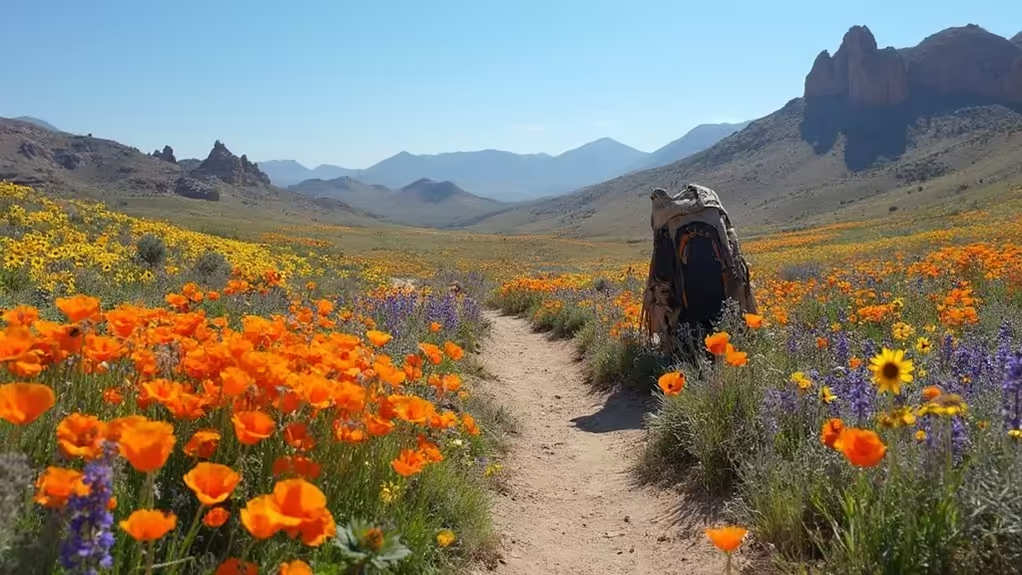
Now that you understand how weather shapes these spectacular displays, let's get you ready for your own wildflower expedition. To catch the most lively desert wildflowers, plan your trip between mid-February and mid-April. Anza-Borrego Desert State Park is a must-see destination, offering breathtaking fields of colorful blooms, along with other best spring wildflower locations across California. Keep an eye on local wildflower hotlines and park websites for up-to-date bloom conditions, ensuring you don't miss the peak viewing times.
For an unforgettable experience, consider joining guided tours that provide:
- Scenic drives through hidden desert terrains
- Expert perspectives into the unique flora and fauna
- Access to off-the-beaten-path viewing spots
As you commence on your expedition, remember to respect the delicate desert ecosystem. Stick to designated trails and resist the urge to pick flowers, preserving the beauty for future visitors. With proper planning and a spirit of exploration, you'll witness nature's incredible palette firsthand. From the golden poppies to the lively lupines, California's desert wildflowers offer a feast for the eyes that'll leave you in awe of the wild's untamed beauty.
Super Bloom Phenomena Explained

Every so often, nature puts on a show that's nothing short of spectacular. In California's deserts, this marvel is known as a super bloom, a rare event that alters barren terrains into lively canvases of wildflowers. You'll witness this breathtaking phenomenon about once every decade, when the perfect storm of weather conditions aligns.
Super blooms require a delicate balance of factors. Late fall or early winter rains, cool days, and chilly nights set the stage for an explosion of color. When precipitation exceeds five inches, it's like nature flips a switch, and the desert comes alive. You'll see a stunning array of flowers, from golden desert golds to fiery California poppies and purple phacelia.
These events are as unpredictable as they are beautiful. Each super bloom is unique, varying in intensity and duration based on the whims of the weather. If you're planning to experience this natural wonder, keep an eye on local forecasts and park updates. When conditions are right, you'll have the chance to immerse yourself in a sea of wildflowers, a reflection of nature's resilience and beauty.
Local Communities and Flower Tourism

Desert communities burst into life when the wildflowers bloom, altering not just the terrain but the local economy as well. As flower tourism takes hold, you'll find these small towns changing into lively hubs of activity. Local communities eagerly welcome visitors, offering a range of experiences to enhance your wildflower journey.
During bloom season, you can:
- Attend colorful festivals celebrating nature's spectacle
- Discover thriving marketplaces filled with local artisans' wares
- Join guided tours led by knowledgeable residents
To make the most of your visit, tap into resources like wildflower hotlines and mobile apps. These tools provide real-time updates on bloom conditions, ensuring you don't miss nature's grand show. As you wander, you'll notice how flower tourism elevates local businesses, from cozy bed-and-breakfasts to charming family-run restaurants.
But it's not just about admiring the flowers. Many communities offer environmental education programs, encouraging responsible tourism and conservation. By participating, you're helping preserve these natural wonders for future generations. So pack your bags, hit the road, and immerse yourself in the freedom of California's desert wildflower blooms – a truly unforgettable experience awaits!
Frequently Asked Questions
Where to See California Superbloom 2024?
Hit the jackpot with California's 2024 superbloom! You'll find nature's freedom at Anza-Borrego Desert State Park, Death Valley National Park, Antelope Valley California Poppy Reserve, Joshua Tree National Park, and Mojave National Preserve. Don't miss these wild spectacles!
What Is the Superbloom in the California Desert?
You'll witness nature's rebellion in the desert when millions of wildflowers burst into bloom simultaneously. It's a rare, breathtaking spectacle that breaks free from the arid terrain, releasing brilliant colors across vast expanses of usually barren ground.
What Month Is the Superbloom in California?
Visualize nature's lively canvas bursting forth! You'll catch the super bloom's peak in mid-March, but you're free to investigate from mid-February through April. Don't let the calendar cage you—Mother Nature's timing can vary yearly.
Where Is the Best Super Bloom in California?
You'll find the best super bloom at Anza-Borrego Desert State Park. It's a wildflower paradise from mid-February to mid-April. Don't miss Death Valley's lively displays or Antelope Valley's poppy fields. Break free and investigate these natural wonders!

